Jackson M.J. Micro and Nanomanufacturing
Подождите немного. Документ загружается.

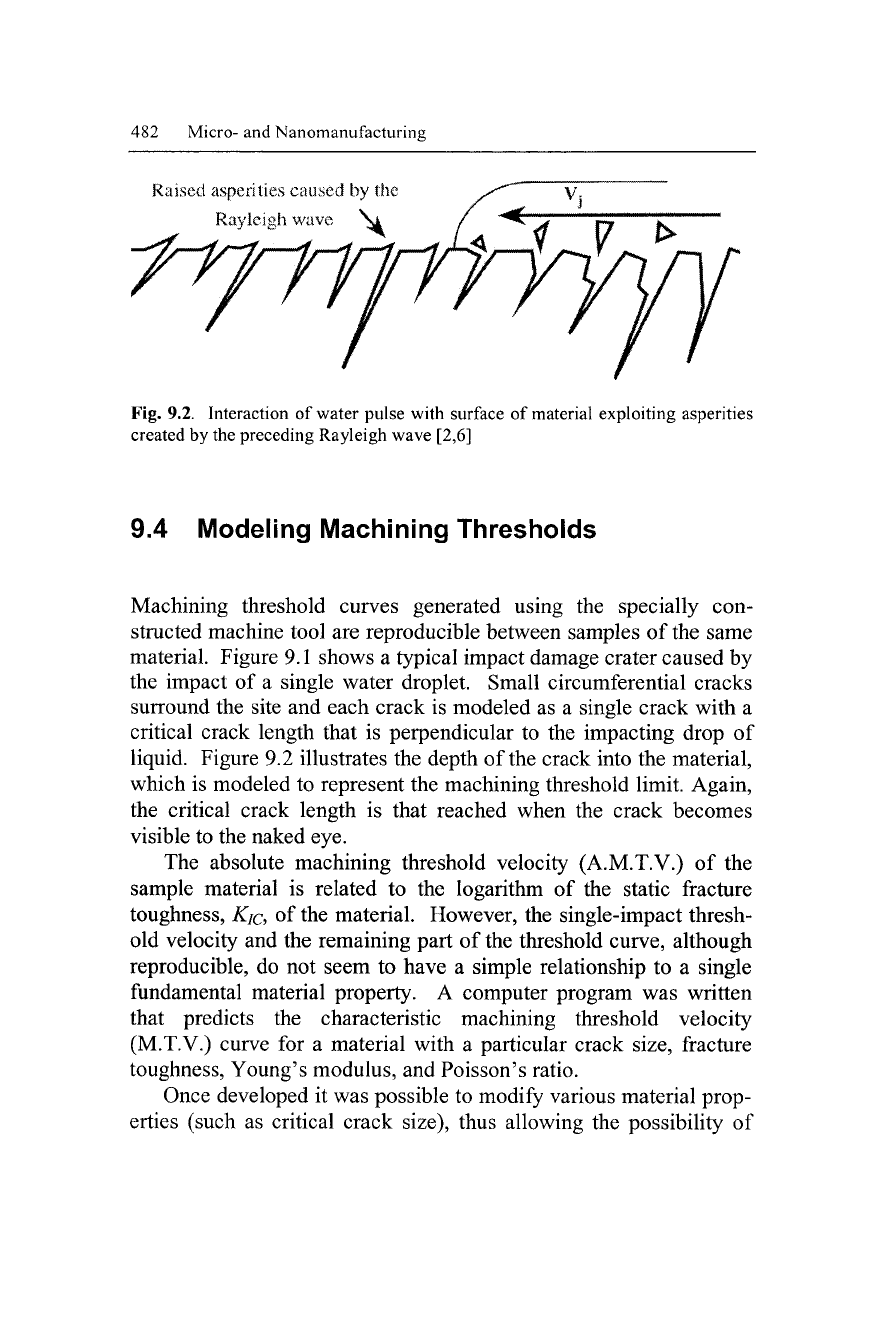
482 Micro- and Nanomanufacturing
Raised asperities caused by the
Rayieisji wave
Fig. 9.2. Interaction of water pulse with surface of material exploiting asperities
created by the preceding Rayleigh wave [2,6]
9.4 Modeling Machining Thresliolds
Machining threshold curves generated using the specially con-
structed machine tool are reproducible between samples of the same
material. Figure 9.1 shows a typical impact damage crater caused by
the impact of a single water droplet. Small circumferential cracks
surround the site and each crack is modeled as a single crack with a
critical crack length that is perpendicular to the impacting drop of
liquid. Figure 9.2 illustrates the depth of the crack into the material,
which is modeled to represent the machining threshold limit. Again,
the critical crack length is that reached when the crack becomes
visible to the naked eye.
The absolute machining threshold velocity (A.M.T.V.) of the
sample material is related to the logarithm of the static fracture
toughness, Kjc, of the material. However, the single-impact thresh-
old velocity and the remaining part of the threshold curve, although
reproducible, do not seem to have a simple relationship to a single
fundamental material property. A computer program was written
that predicts the characteristic machining threshold velocity
(M.T.V.) curve for a material with a particular crack size, fracture
toughness. Young's modulus, and Poisson's ratio.
Once developed it was possible to modify various material prop-
erties (such as critical crack size), thus allowing the possibility of
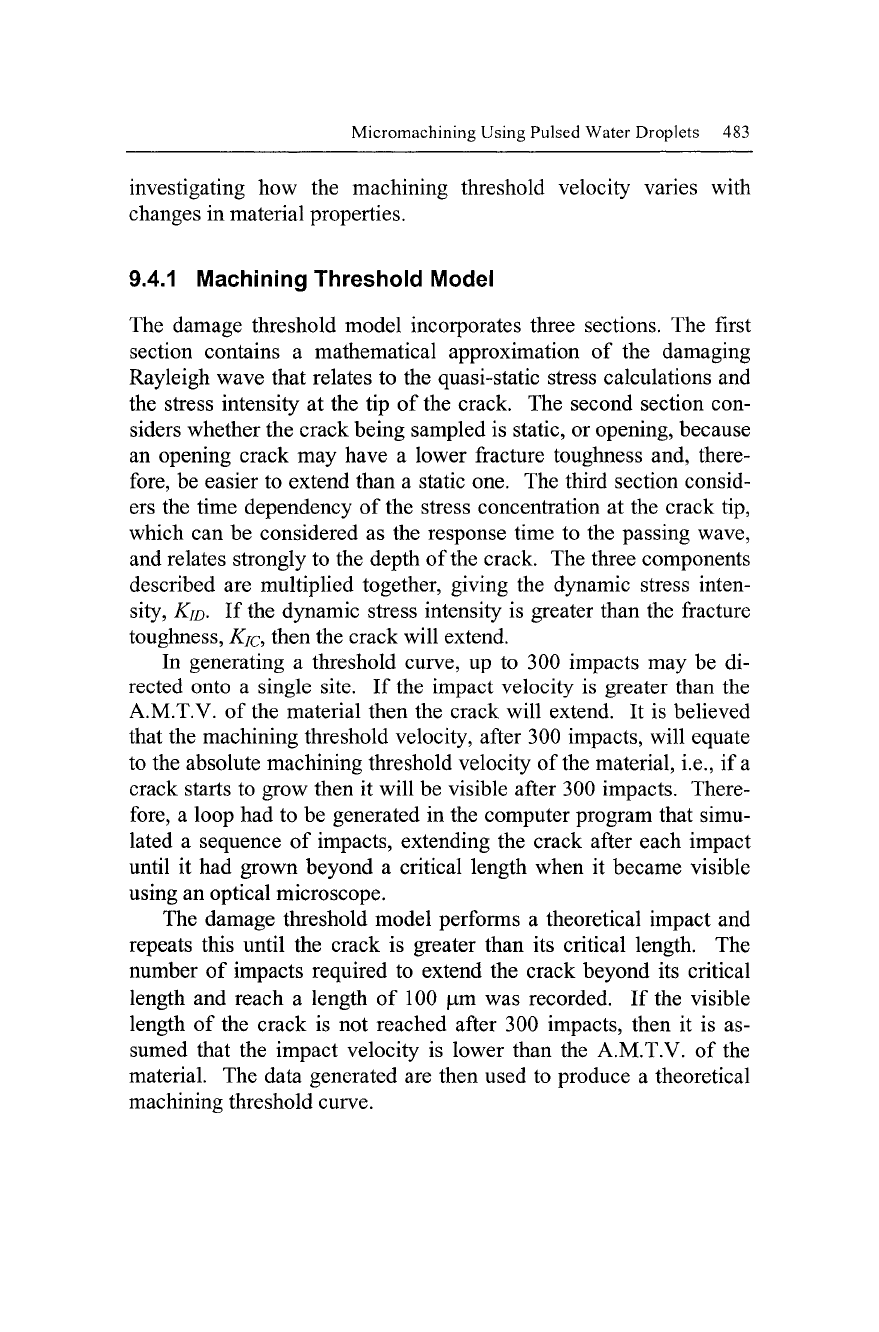
Micromachining Using Pulsed Water Droplets 483
investigating how the machining threshold velocity varies with
changes in material properties.
9.4.1 Machining Threshold IVIodel
The damage threshold model incorporates three sections. The first
section contains a mathematical approximation of the damaging
Rayleigh wave that relates to the quasi-static stress calculations and
the stress intensity at the tip of the crack. The second section con-
siders whether the crack being sampled is static, or opening, because
an opening crack may have a lower fracture toughness and, there-
fore,
be easier to extend than a static one. The third section consid-
ers the time dependency of the stress concentration at the crack tip,
which can be considered as the response time to the passing wave,
and relates strongly to the depth of the crack. The three components
described are multiplied together, giving the dynamic stress inten-
sity.
KID.
If the dynamic stress intensity is greater than the fracture
toughness, Kjc, then the crack will extend.
In generating a threshold curve, up to 300 impacts may be di-
rected onto a single site. If the impact velocity is greater than the
A.M.T.V. of the material then the crack will extend. It is believed
that the machining threshold velocity, after 300 impacts, will equate
to the absolute machining threshold velocity of the material, i.e., if a
crack starts to grow then it will be visible after 300 impacts. There-
fore,
a loop had to be generated in the computer program that simu-
lated a sequence of impacts, extending the crack after each impact
until it had grown beyond a critical length when it became visible
using an optical microscope.
The damage threshold model performs a theoretical impact and
repeats this until the crack is greater than its critical length. The
number of impacts required to extend the crack beyond its critical
length and reach a length of 100 |Lim was recorded. If the visible
length of the crack is not reached after 300 impacts, then it is as-
sumed that the impact velocity is lower than the A.M.T.V. of the
material. The data generated are then used to produce a theoretical
machining threshold curve.
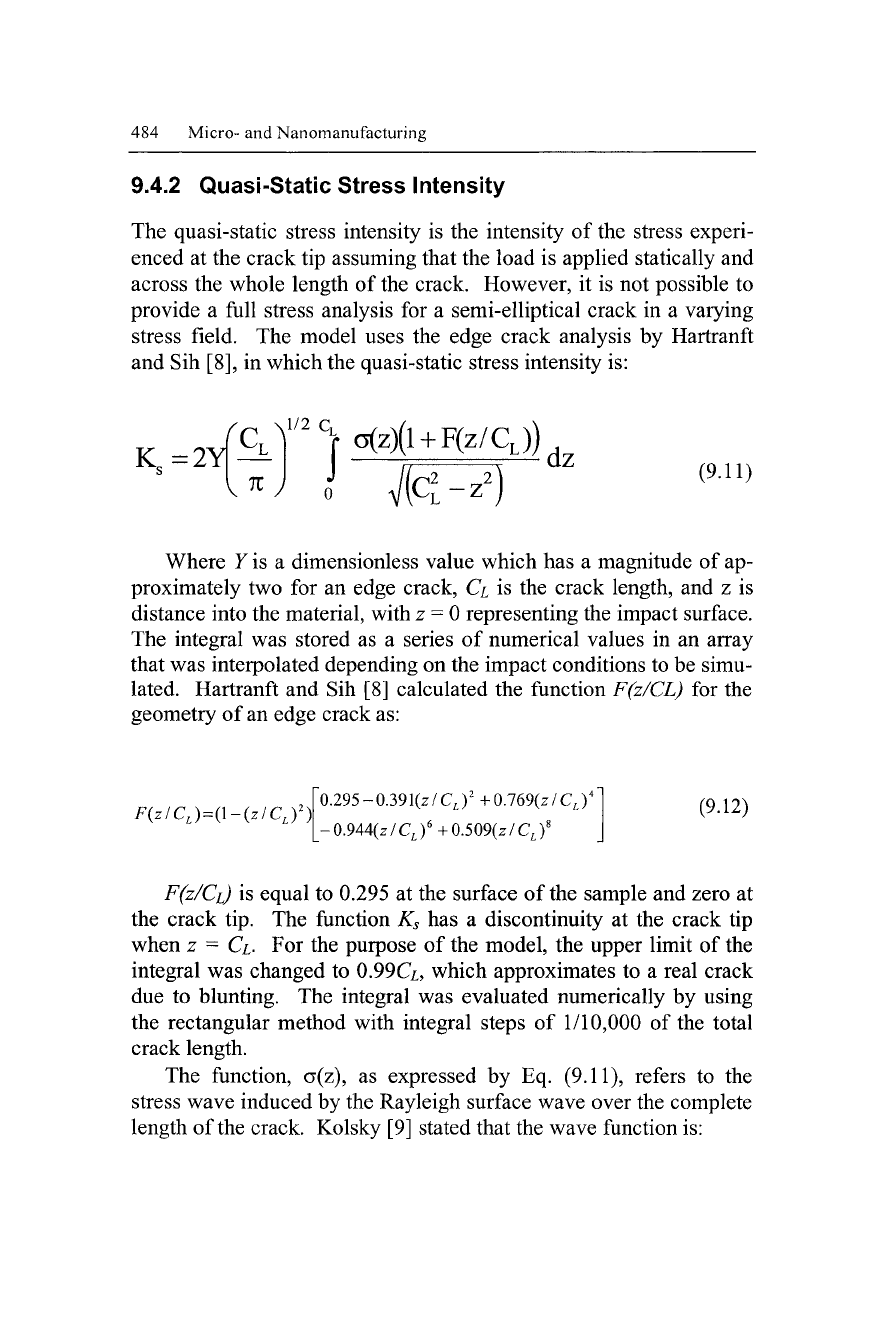
484 Micro- and Nanomanufacturing
9.4.2 Quasi-Static Stress Intensity
The quasi-static stress intensity is the intensity of the stress experi-
enced at the crack tip assuming that the load is appHed statically and
across the whole length of the crack. However, it is not possible to
provide a full stress analysis for a semi-elliptical crack in a varying
stress field. The model uses the edge crack analysis by Hartranft
and Sih [8], in which the quasi-static stress intensity is:
K =2M
I^QY
"-f
o(z)(l
+ F(z/Cj)
Where 7 is a dimensionless value which has a magnitude of ap-
proximately two for an edge crack, d is the crack length, and z is
distance into the material, with z
=
0 representing the impact surface.
The integral was stored as a series of numerical values in an array
that was interpolated depending on the impact conditions to be simu-
lated. Hartranft and Sih [8] calculated the function F(z/CL) for the
geometry of an edge crack as:
F{zlC,)={\-{zlC,f)\
0.295 - 0.39 l(z/C J' +0.769(z/Cj'
-0.944(z/Q)' +0.509(z/Cj'
(9.12)
F(Z/CL)
is equal to 0.295 at the surface of the sample and zero at
the crack tip. The function Ks has a discontinuity at the crack tip
when z = Ci. For the purpose of the model, the upper limit of the
integral was changed to 0.99Ci, which approximates to a real crack
due to blunting. The integral was evaluated numerically by using
the rectangular method with integral steps of
1/10,000
of the total
crack length.
The function, a(z), as expressed by Eq. (9.11), refers to the
stress wave induced by the Rayleigh surface wave over the complete
length of the crack. Kolsky [9] stated that the wave function is:
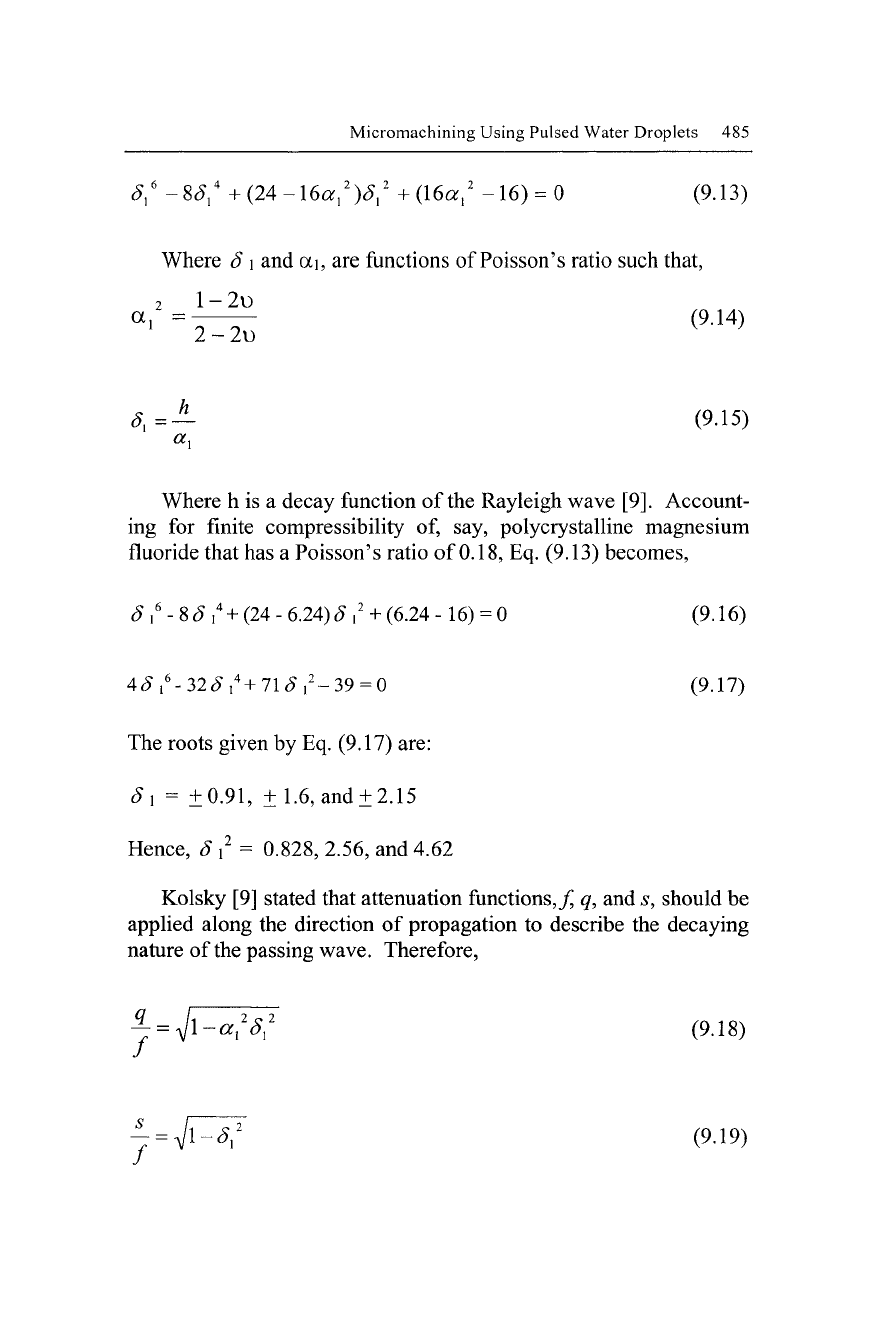
Micromachining Using Pulsed Water Droplets 485
<5,'-8^/+(24-16a,')(5,'+(16«,' -16) = 0 (9.13)
Where 5 \ and ai, are functions of Poisson's ratio such that,
2 l-2u
a, = (9.14)
' 2-2o ^ '
d,=—
(9.15)
^1
a
Where h is a decay function of the Rayleigh wave [9]. Account-
ing for finite compressibiHty of, say, polycrystalHne magnesium
fluoride that has a Poisson's ratio of
0.18,
Eq. (9.13) becomes,
^ i' -
8
J i'+ (24 - 6.24)^ i' + (6.24 -16) = 0 (9.16)
A5 i'- 32^ i'+
71 c5
i'- 39 = 0 (9.17)
The roots given by Eq. (9.17) are:
S\ =
±0.91,
±1.6,and±2.15
Hence, S i^ = 0.828, 2.56, and 4.62
Kolsky [9] stated that attenuation functions,/ q, and
5,
should be
applied along the direction of propagation to describe the decaying
nature of the passing wave. Therefore,
j: =
^\-a,'S,'
(9.18)
J
=
^F^
(9-19)
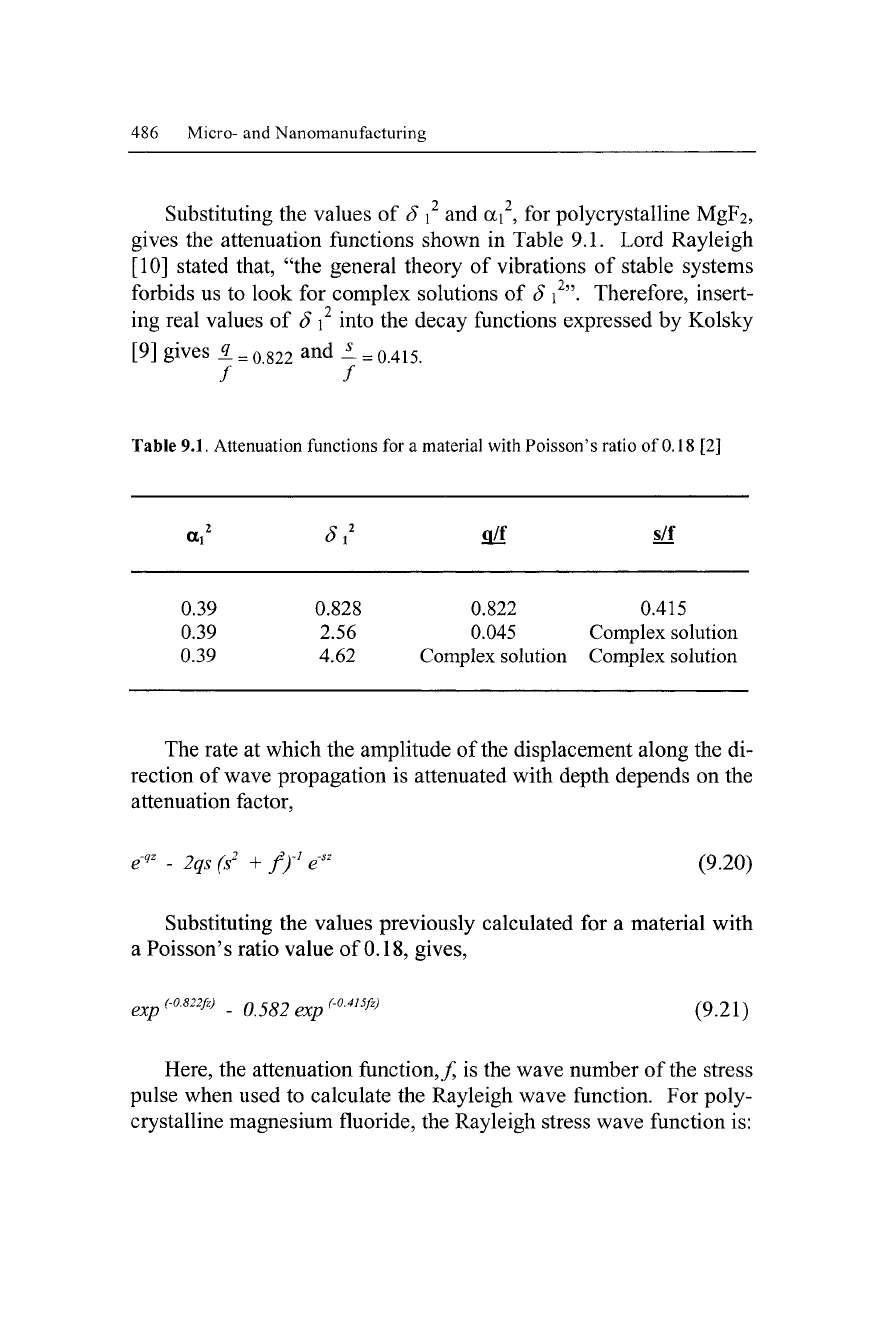
486 Micro- and Nanomanufacturing
Substituting the values of S \ and (X\, for polycrystalline MgF2,
gives the attenuation functions shown in Table 9.1. Lord Rayleigh
[10] stated that, "the general theory of vibrations of stable systems
forbids us to look for complex solutions of 8 \'\ Therefore, insert-
ing real values of 5 \ into the decay functions expressed by Kolsky
0.39
0.39
0.39
0.828
2.56
4.62
[9] gives
9.
=
0.822 and £
=
o.4l5.
/ /
Table 9.1. Attenuation functions for a material with Poisson's ratio of 0.18 [2]
ai'
5^ fl/f s/f
0.822 0.415
0.045 Complex solution
Complex solution Complex solution
The rate at which the amplitude of the displacement along the di-
rection of wave propagation is attenuated with depth depends on the
attenuation factor,
e"^'
- 2qs (s' + //' e'' (9.20)
Substituting the values previously calculated for a material with
a Poisson's ratio value of
0.18,
gives,
exp ^-'-'''^'^
-
0.582
exp
^-'-'^'^'^
(9.21)
Here, the attenuation function,/ is the wave number of the stress
pulse when used to calculate the Rayleigh wave function. For poly-
crystalline magnesium fluoride, the Rayleigh stress wave function is:
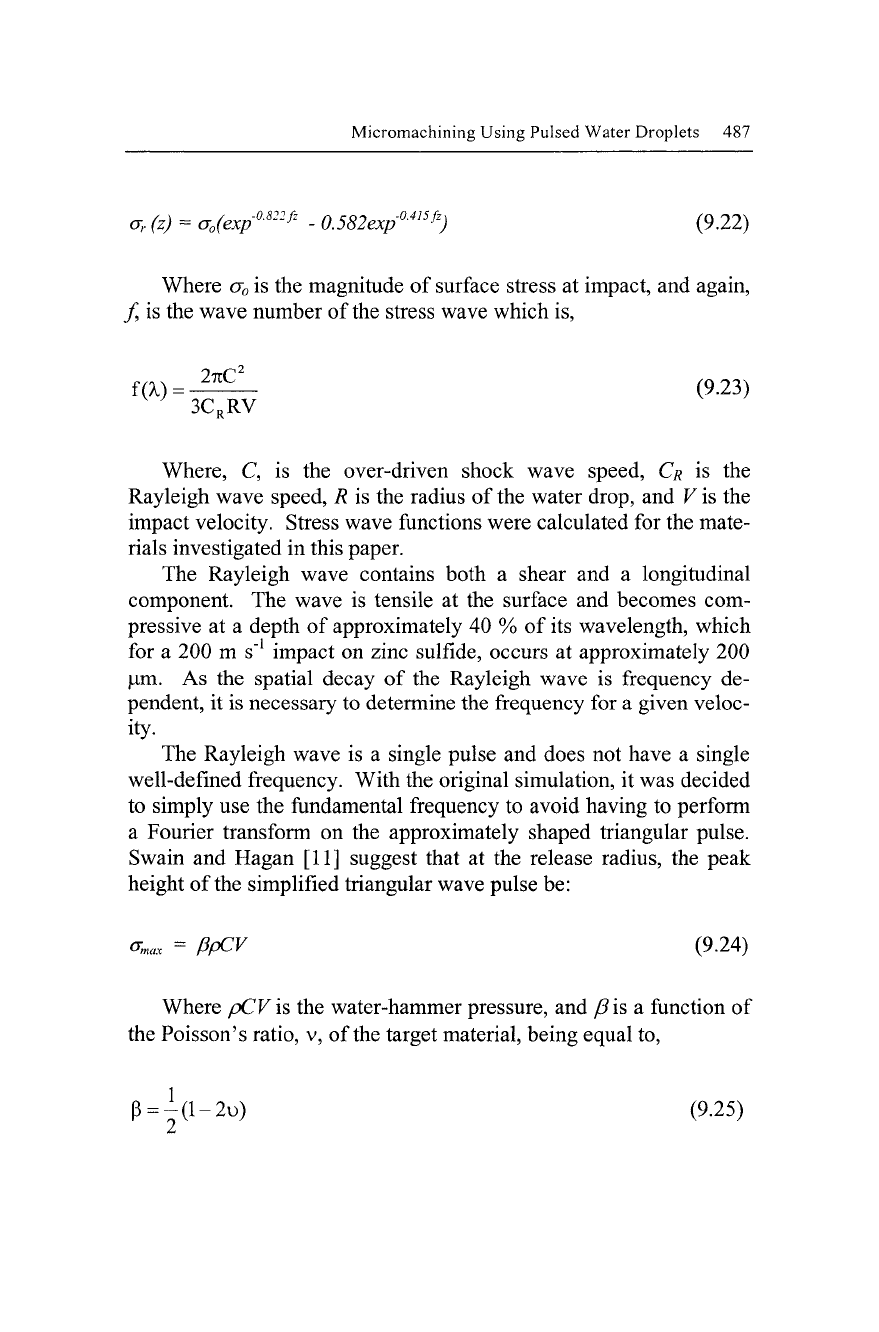
Micromachining Using Pulsed Water Droplets 487
Gr
(z)
=
(Jo(exp'-'''^'
-
0.582exp''''^')
(9.22)
Where
GQ
is the magnitude of surface stress at impact, and again,
f, is the wave number of the stress wave which is.
f(X)
=
J!^ (9.23)
3CRRV
Where, C, is the over-driven shock wave speed, CR is the
Rayleigh wave speed, R is the radius of the water drop, and V is the
impact velocity. Stress wave functions were calculated for the mate-
rials investigated in this paper.
The Rayleigh wave contains both a shear and a longitudinal
component. The wave is tensile at the surface and becomes com-
pressive at a depth of approximately 40 % of its wavelength, which
for a 200 m s"^ impact on zinc sulfide, occurs at approximately 200
|Lim. As the spatial decay of the Rayleigh wave is frequency de-
pendent, it is necessary to determine the frequency for a given veloc-
ity.
The Rayleigh wave is a single pulse and does not have a single
well-defined frequency. With the original simulation, it was decided
to simply use the fundamental frequency to avoid having to perform
a Fourier transform on the approximately shaped triangular pulse.
Swain and Hagan [11] suggest that at the release radius, the peak
height of the simplified triangular wave pulse be:
(Tmax
=
PPCV
(9.24)
Where pCV is the water-hammer pressure, and y^is a function of
the Poisson's ratio, v, of the target material, being equal to.
P =
l(l-2u) (9.25)
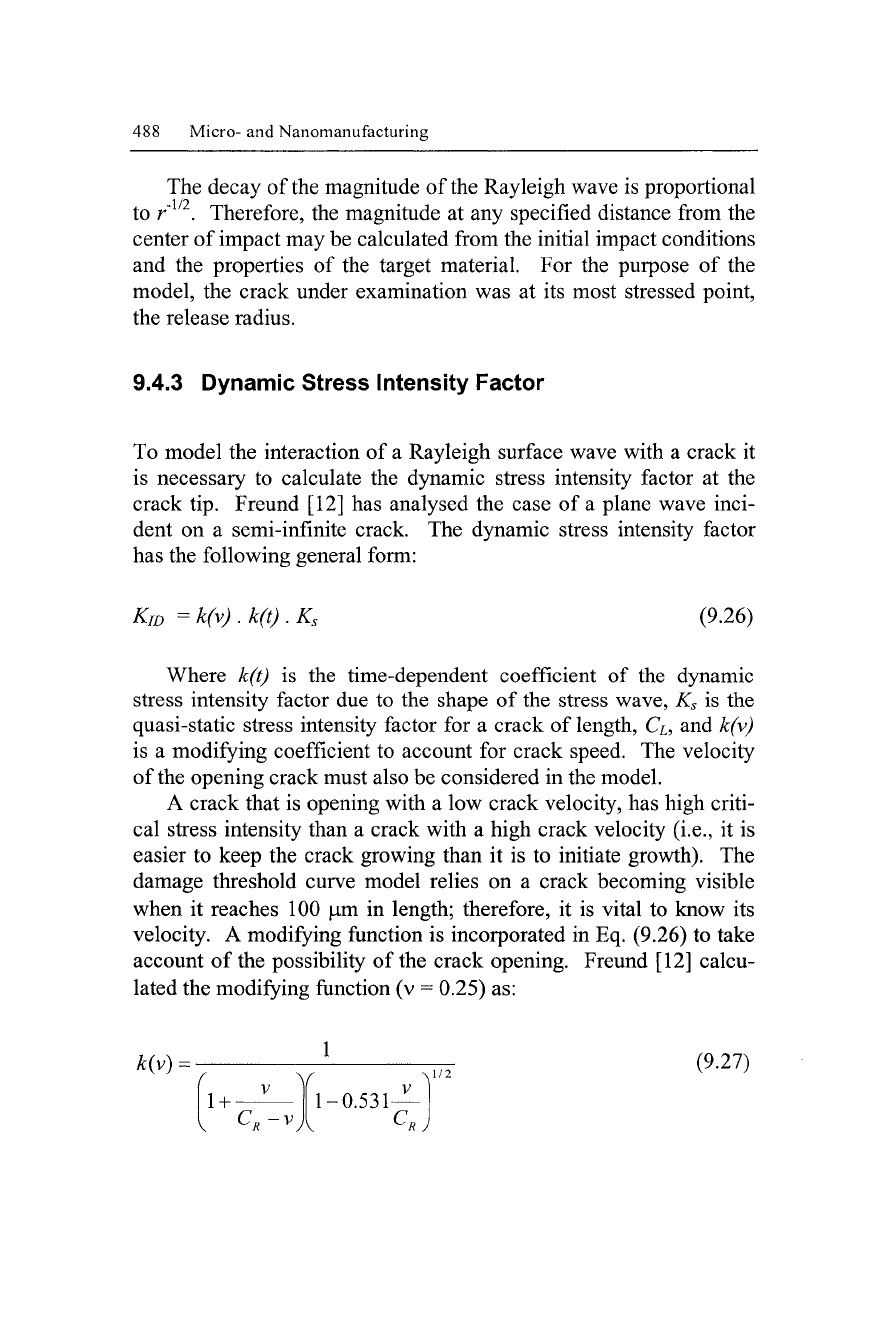
488 Micro- and Nanomanufacturing
The decay of the magnitude of the Rayleigh wave is proportional
to f^'^. Therefore, the magnitude at any specified distance from the
center of impact may be calculated from the initial impact conditions
and the properties of the target material. For the purpose of the
model, the crack under examination was at its most stressed point,
the release radius.
9.4.3 Dynamic Stress Intensity Factor
To model the interaction of a Rayleigh surface wave with a crack it
is necessary to calculate the dynamic stress intensity factor at the
crack tip. Freund [12] has analysed the case of a plane wave inci-
dent on a semi-infinite crack. The dynamic stress intensity factor
has the following general form:
KID
= k(v) . k(t) . Ks (9.26)
Where k(t) is the time-dependent coefficient of the dynamic
stress intensity factor due to the shape of the stress wave, Ks is the
quasi-static stress intensity factor for a crack of length, Q, and k(v)
is a modifying coefficient to account for crack speed. The velocity
of the opening crack must also be considered in the model.
A crack that is opening with a low crack velocity, has high criti-
cal stress intensity than a crack with a high crack velocity (i.e., it is
easier to keep the crack growing than it is to initiate growth). The
damage threshold curve model relies on a crack becoming visible
when it reaches 100 |Lim in length; therefore, it is vital to know its
velocity. A modifying function is incorporated in Eq. (9.26) to take
account of the possibility of the crack opening. Freund [12] calcu-
lated the modifying function (v = 0.25) as:
^M = 7 —^
TTTT (9-2V)
1
+ ^^
1-0.531—
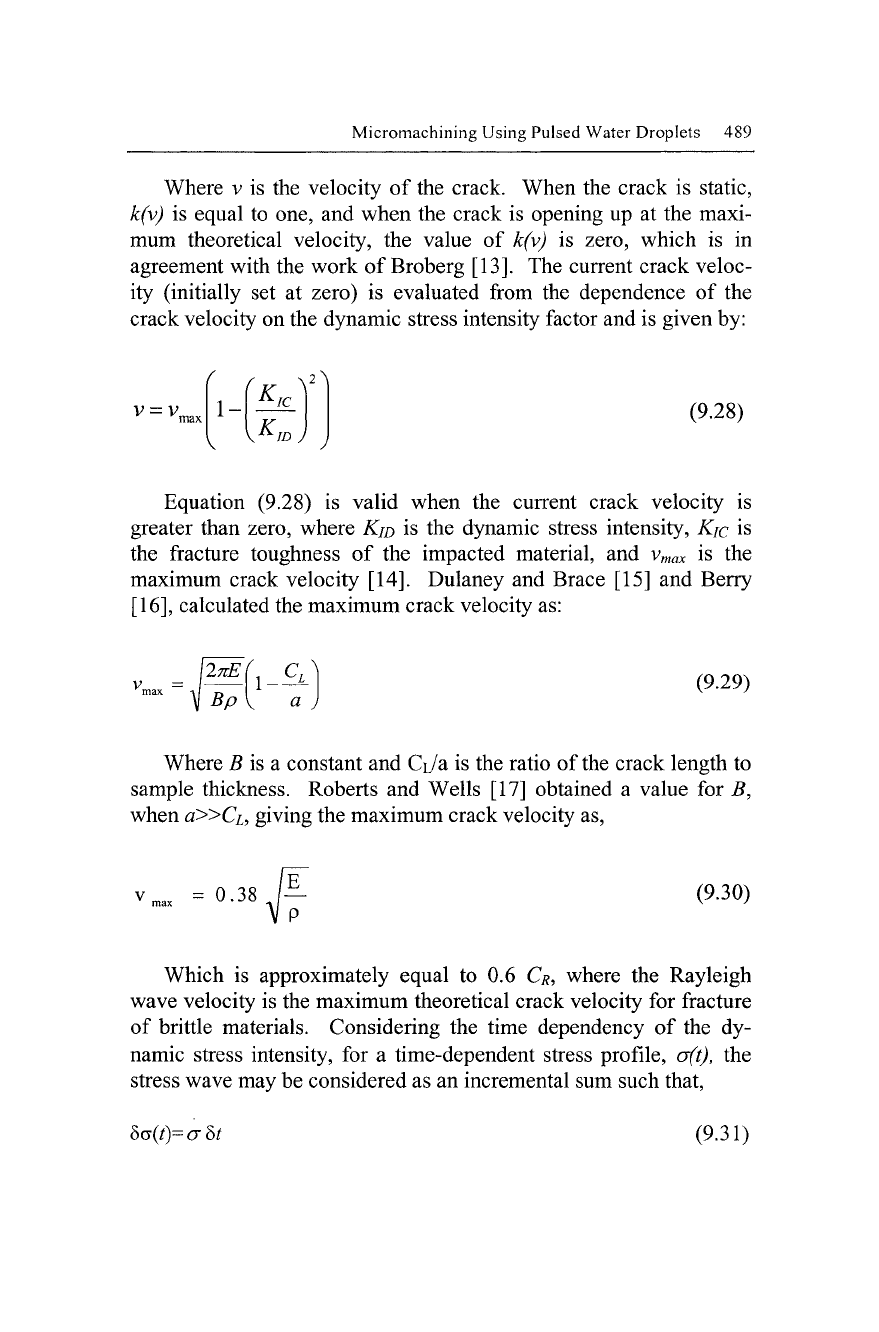
Micromachining Using Pulsed Water Droplets 489
Where v is the velocity of the crack. When the crack is static,
k(v) is equal to one, and when the crack is opening up at the maxi-
mum theoretical velocity, the value of k(v) is zero, which is in
agreement with the work of Broberg [13]. The current crack veloc-
ity (initially set at zero) is evaluated from the dependence of the
crack velocity on the dynamic stress intensity factor and is given by:
f
v = v^
1-
fK ^
2\
IC
\^ID J
(9.28)
Equation (9.28) is valid when the current crack velocity is
greater than zero, where
KJD
is the dynamic stress intensity, Kjc is
the fracture toughness of the impacted material, and
Vmax
is the
maximum crack velocity [14]. Dulaney and Brace [15] and Berry
[16],
calculated the maximum crack velocity as:
ITTE
U-
Cr
(9.29)
Where 5 is a constant and CJdi is the ratio of the crack length to
sample thickness. Roberts and Wells [17] obtained a value for 5,
when a»Ci, giving the maximum crack velocity as.
0.38
(9.30)
Which is approximately equal to 0.6 CR, where the Rayleigh
wave velocity is the maximum theoretical crack velocity for fracture
of brittle materials. Considering the time dependency of the dy-
namic stress intensity, for a time-dependent stress profile, G(t), the
stress wave may be considered as an incremental sum such that.
bc5{i)=(jbt
(9.31)
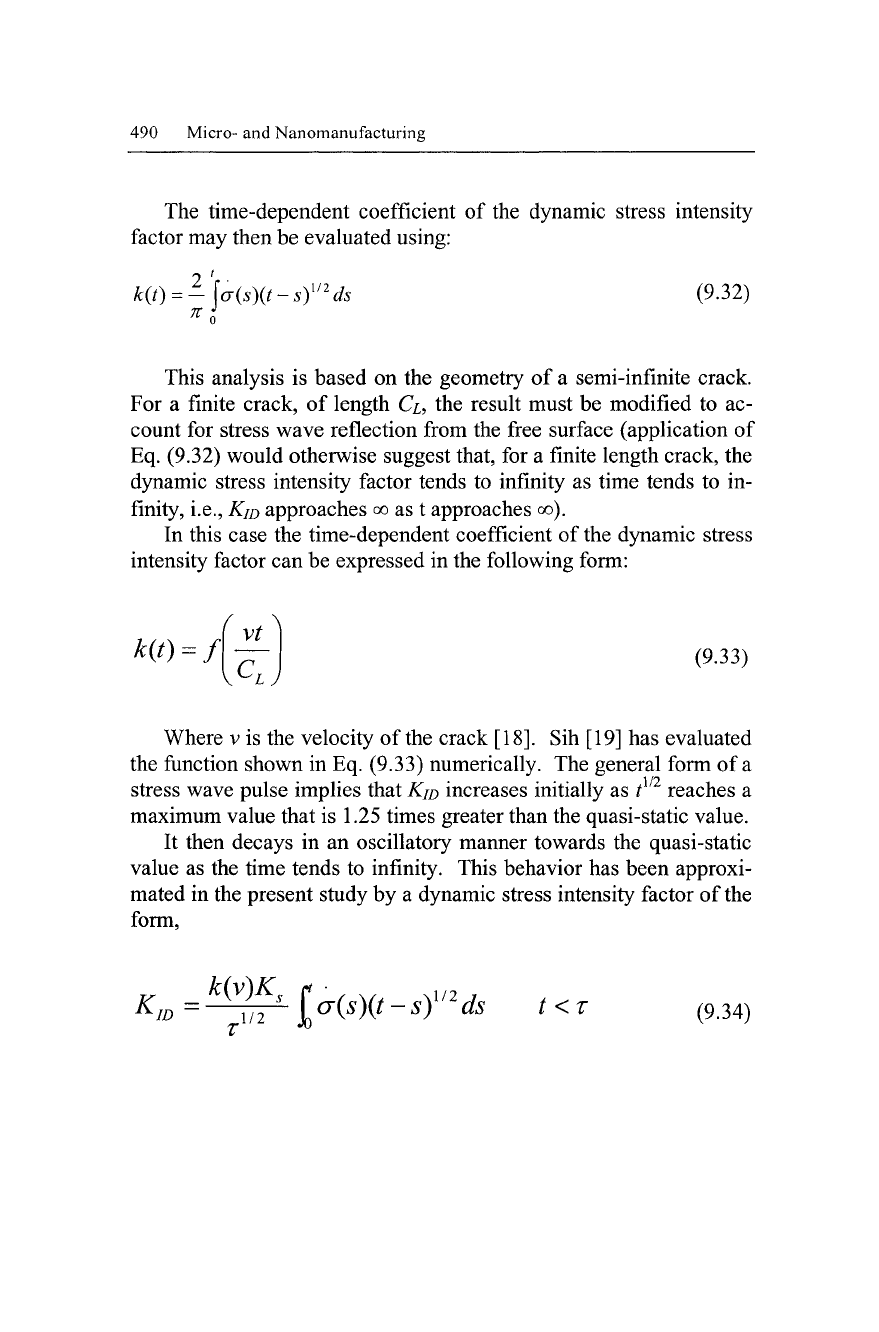
490 Micro- and Nanomanufacturing
The time-dependent coefficient of the dynamic stress intensity
factor may then be evaluated using:
k(t)
=
-\ais){t-sf'ds
(9.32)
^0
This analysis is based on the geometry of a semi-infinite crack.
For
a
finite crack, of length
d,
the result must be modified to ac-
count for stress wave reflection from the free surface (application of
Eq. (9.32) would otherwise suggest that, for a finite length crack, the
dynamic stress intensity factor tends to infinity as time tends to in-
finity, i.e., Kjo approaches
oo
as
t
approaches oo).
In this case the time-dependent coefficient of the dynamic stress
intensity factor can be expressed in the following form:
Kt)
=
f
(9.33)
Where v is the velocity of the crack [18]. Sih [19] has evaluated
the function shown in Eq. (9.33) numerically. The general form of a
stress wave pulse implies that Km increases initially as
t^'^
reaches
a
maximum value that is 1.25 times greater than the quasi-static value.
It then decays in an oscillatory manner towards the quasi-static
value as the time tends to infinity. This behavior has been approxi-
mated in the present study by a dynamic stress intensity factor of the
form.
Kto=^^^^[<y{s){t-sf^ds
t<T
(9.34)
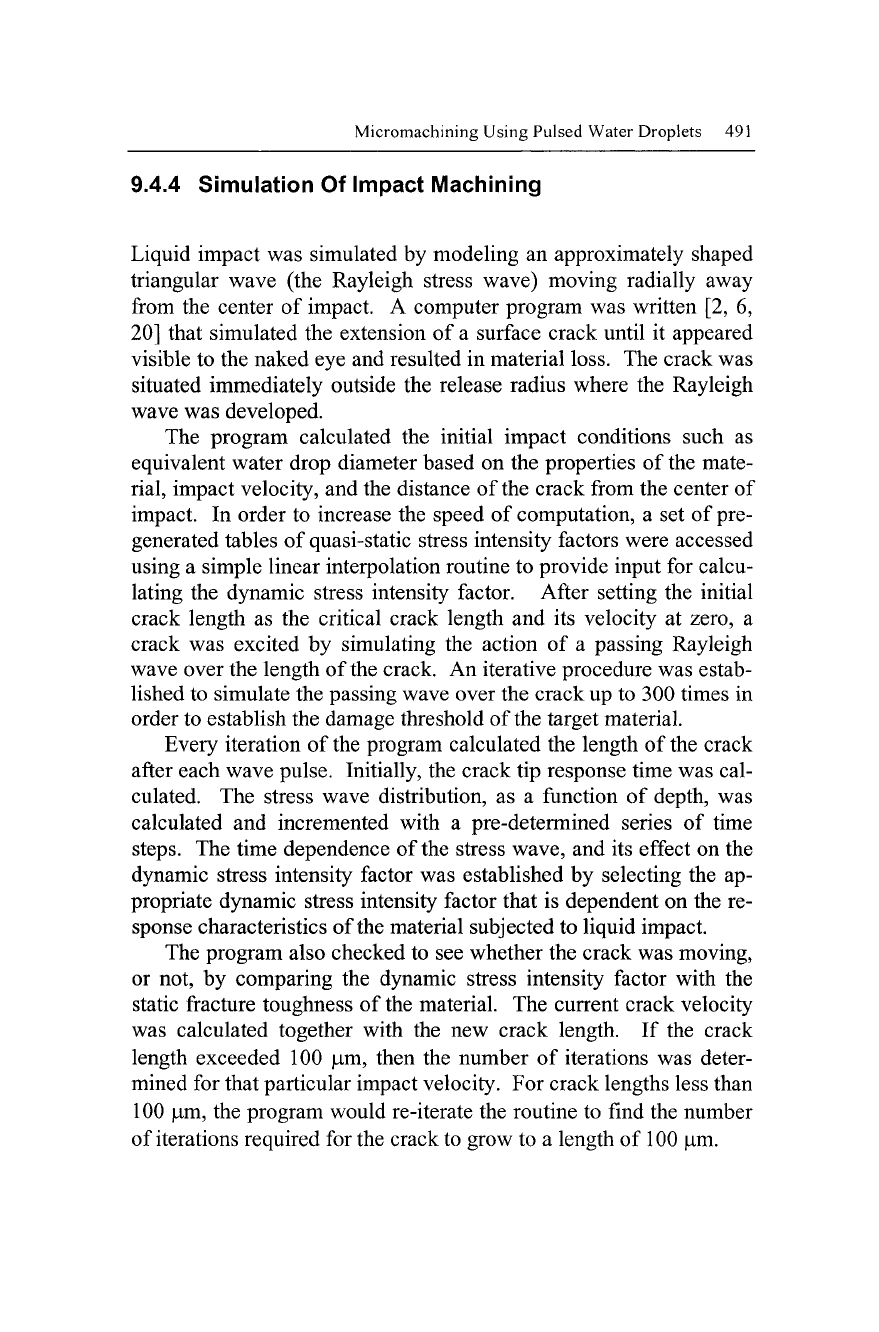
Micromachining Using Pulsed Water Droplets 491
9.4.4 Simulation Of Impact Machining
Liquid impact was simulated by modeling an approximately shaped
triangular wave (the Rayleigh stress wave) moving radially away
from the center of impact. A computer program was written [2, 6,
20] that simulated the extension of a surface crack until it appeared
visible to the naked eye and resulted in material loss. The crack was
situated immediately outside the release radius where the Rayleigh
wave was developed.
The program calculated the initial impact conditions such as
equivalent water drop diameter based on the properties of the mate-
rial,
impact velocity, and the distance of the crack from the center of
impact. In order to increase the speed of computation, a set of pre-
generated tables of quasi-static stress intensity factors were accessed
using a simple linear interpolation routine to provide input for calcu-
lating the dynamic stress intensity factor. After setting the initial
crack length as the critical crack length and its velocity at zero, a
crack was excited by simulating the action of a passing Rayleigh
wave over the length of the crack. An iterative procedure was estab-
lished to simulate the passing wave over the crack up to 300 times in
order to establish the damage threshold of the target material.
Every iteration of the program calculated the length of the crack
after each wave pulse. Initially, the crack tip response time was cal-
culated. The stress wave distribution, as a function of depth, was
calculated and incremented with a pre-determined series of time
steps.
The time dependence of the stress wave, and its effect on the
dynamic stress intensity factor was established by selecting the ap-
propriate dynamic stress intensity factor that is dependent on the re-
sponse characteristics of the material subjected to liquid impact.
The program also checked to see whether the crack was moving,
or not, by comparing the dynamic stress intensity factor with the
static fracture toughness of the material. The current crack velocity
was calculated together with the new crack length. If the crack
length exceeded 100 jum, then the number of iterations was deter-
mined for that particular impact velocity. For crack lengths less than
100 |um, the program would re-iterate the routine to find the number
of iterations required for the crack to grow to a length of 100 |um.
